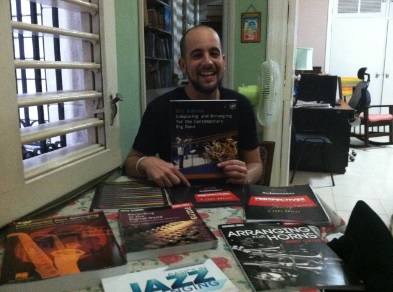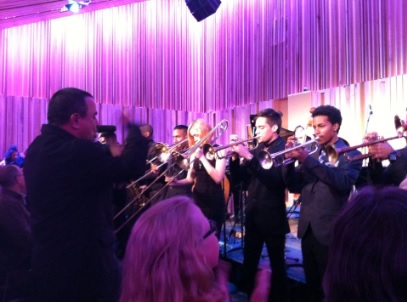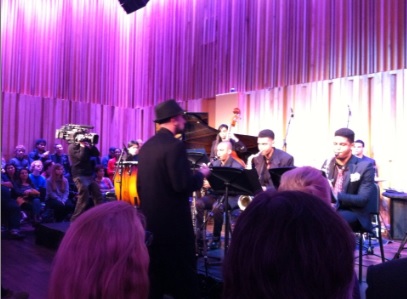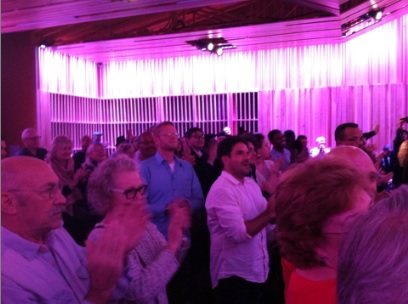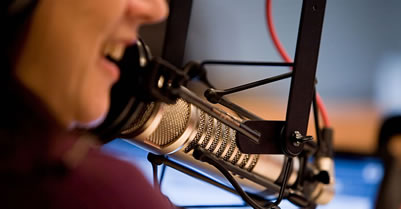Blog, Cuba, Cuban Jazz, Latin Jazz, The Cuba-US connection, Video and audio
 Camilo Moreira our heroic educator in Havana
Camilo Moreira our heroic educator in HavanaJazz has been in Cuba for almost as long as jazz has existed. In fact, Cuban music was one of the contributors to the formation of jazz in its earliest years. (See Jelly Roll Morton’s comment on the essential role of the “Spanish tinge” in achieving the jazz feel.)
In spite of this long history, being a jazz musician in Cuba has not been easy for the last 55+ years since the free flow of audiences, musicians, records, and scores was cut off.
Cubans have extremely limited access to the Internet and the world market price of a single CD is the equivalent of a full week’s salary for them. Books, scores, and travel are correspondingly expensive and difficult to arrange.
While Cuba has an outstanding system for education in classical music (one of the best in the world), jazz education is carried out largely outside the academy and with little to no financial support.
How then does Cuba manage to produce so many world class jazz musicians?
Individual initiative and the passion and dedication of the country’s jazz community.
Growing the next generation of Cuban jazz musicians
Fledgling jazz musicians need the chance to learn their instruments, play with others, and master the theory that underpins the music.
One of the key figures in making these opportunities available to young people in Cuba today is Camilo Moreira, a friend of Jazz on the Tube.
A fine guitarist who has shifted his focus to education and composition, Camilo is a summa cum laude graduate of the Cuba’s top performing arts school University of the Arts (ISA) where he was recognized by the faculty as the best student-teacher of his graduating class.
Since 2010, he’s been teaching harmony, composition, computer music and ensemble practice at the country’s top conservatory for secondary students, the National School of Music (ENA). He also directs the school’s jazz band which was recently invited to perform at Jazz at Lincoln Center in April of 2016.
This year (2017), Camilo has taken on the important task of reviving and directing ISA’s Jazz Band. This is easily the most important jazz education initiative in the country.
How you can to help
As you can see from the picture above, Camilo likes books on composing, arranging and theory. They’re treasures to him.
For any of us, getting books on any subject is a simple matter of going to Amazon, spending a few bucks, and clicking send.
But there is no Amazon for Cubans and even if there were, a single music text can cost Camilo the equivalent of a month’s salary or more.
Up until now, that’s how he’s gotten his books, painstakingly saving his money and acquiring them catch-as-catch-can.
No more.
Jazz on the Tube has asked Camilo to give us his shopping list of the books he needs to continue his work as a teacher, arranger and composer.
We’re also on the lookout for scores and charts from, especially but not limited to, Machito and Mario Bauza, Tito Puente, Pérez Prado, and others who brought Cuban music into big band settings.
If you’re a promising young musician in Cuba, as a secondary student, you’re in ENA and as a university student, you’re in ISA. In both places Camilo is the face of jazz and we want to help him in his mission every way we can.
The power of positive leverage
It’s rare in life that such modest inputs (books and other support) have the potential to have such an oversized output.
If you’d like to be part of this project, please include a note to that effect with your next contribution to Jazz on the Tube and we’ll make sure the money you send is used for the purpose of supporting jazz education in Cuba.
By the way, in addition to being a first rate educator, Camilo is also an accomplished composer and arranger.
Using the old “sneaker net” method – flash drives passed from hand-to-hand instead of the Internet which as stated before is not easily accessed in Cuba – we’ve put some of his work online for you to enjoy.
Support Jazz on the Tube’s education projects in Cuba
Camilo wrote the score for the Cuban-made feature film “La Isla de Corcho” (“Cork Island”)
A Camilo Moreira composition and arrangement sung by Luna Manzanares: “Dejo Una Cancion”
Camilo Moreira wrote this one too: “El Trapezio de La Luna” Performed by friends and classmates from ISA. (A first reading.)
– Ken McCarthy
Jazz on the Tube
P.S. Our unique programming is made possible by help from people like you. Learn how you can contribute to our efforts here: Support Jazz on the Tube
Thanks.
Afro-Cuban culture, Blog, Cuban Jazz, Latin Jazz, The Cuba-US connection

Giovanni Russonello shines a light on two things we’ve been writing about a lot in recent years:
The sublime pleasures of Latin Jazz and the incredible new generation of players and composers who merit a lot more attention than they are currently getting.
This appeared in today’s (February 11, 2017) New York Times:
Latin Jazz is Booming. Look Beyond the Grammys to Find It.
By Giovanni Russonello
When the Grammy Awards eliminated the category of best Latin jazz album six years ago, an outcry arose quickly. Musicians and advocates argued that the move cut off a rare source of institutional recognition for a genre at the commercial fringes. And the academy listened. The next year the category returned.
In the years since, the importance of that recognition has become even clearer: Latin jazz is experiencing a kind of creative bloom, with musicians diversifying their work at an uncommon clip. It’s generating some of the most invigorating improvised music around.
So maybe it is a bit disappointing that the Grammy nominations this year don’t fully reflect those developments, focusing instead on older musicians. Every nominee up for best Latin jazz album this Sunday is over 60.
More: https://www.nytimes.com/2017/02/10/arts/music/grammys-latin-jazz.html?_r=0
– Ken McCarthy
Jazz on the Tube
P.S. Our unique programming is made possible by help from people like you. Learn how you can contribute to our efforts here: Support Jazz on the Tube
Thanks.

Blog, Cuba, Cuban Jazz, Latin Jazz, The Cuba-US connection, Video and audio
New Orleans and Havana have a long history together.
For a while (1762 to 1802) when Louisiana (“Luisiana” in Spanish) was a Spanish holding, New Orleans was administered by Havana and the Spanish left behind many beautiful buildings.
Much of the French Quarter was actually built by the Cubans after a catastrophic fire destroyed most of the old city in 1788.
U.S. troops about to enter the Spanish-American War, which included the liberation of Cuba from Spanish control, shipped out of New Orleans and returned there (which is why New Orleans was full of used brass instruments around the turn of the century.)
Also, several members of important community brass bands were part of the force that invaded and then occupied Havana after the war. You can be sure they brought back some Cuban feel from the experience.
Dave Bartholomew, the New Orleanian who put his formative stamp on rock ‘n roll in the late 1940s, says he got the riff from his iconic “Country Boy” (used later on thousands of rock tunes including Elvis Presley’s “Hound Dog”) from a Cuba Son record.
And on and on it goes.
The history continued in January of 2017 with a visit by high school jazz students from Havana to New Orleans, the first such visit in at least 60 years (possibly the first such visit ever.)
The kids worked with musicians at Preservation Hall and gave a performance which was received enthusiastically by the city’s discriminating jazz fans.
In the captions below, we note the names of the Cuban educators who train and manage the band, two of the great unsung heroes in the Horns to Havana organization: Enrique Toledo and Camilo Moreira.
 Orchestra Director Enrique Toledo
Orchestra Director Enrique Toledo
 Camilo Moreira conducts
Camilo Moreira conducts
 Standing ovation in New Orleans for the kids from Cuba
Standing ovation in New Orleans for the kids from CubaEnrique Toledo conducts the Conservatorio Amadeo Roldán Jazz Orchestra in Havana, January 2016.
– Ken McCarthy
Jazz on the Tube
P.S. Our unique programming is made possible by help from people like you. Learn how you can contribute to our efforts here: Support Jazz on the Tube
Thanks.
Afro-Cuban culture, Blog, Cuba, Cuban Jazz, The Cuba-US connection, Video and audio
Steve Coleman in Matanzas (2017) with members of Rumba Timba. The group is made up of some of the younger members of Los Muñequitos de Matanzas. Luis Cancino Morales on the bells.
2016 marked Steve Coleman’s 20th year of exploring and playing in Cuba.
It all started with Coleman’s interest in the philosophical underpinnings of music and how complex cultural ideas are transmitted through music.
Anyone interested in this subject has to look to Africa and anyone in North America interested in African culture would do well to take a prolonged trip to Cuba.
Why Cuba?
For one thing it’s closer, but more importantly for historical reasons the concentration and variety of African cultural systems in Cuba is unprecedented anywhere on earth – even in Africa itself.
Coleman’s first visit to Cuba was in January 1996 where he wisely went straight to Mantazas one of the wellsprings of Afro-Cuban Culture.
This was followed up by a twelve day long collaboration in Havana with AfroCuba de Matanzas in February of the same year.
This initial collaboration culminated in a performance at the Havana Jazz Festival and a recording session at Egrem which produced the album “The Sign and The Seal by Steve Coleman and The Mystic Rhythm Society.
Here’s a documentary shot during the years right before Coleman went to Cuba (1993 to 1995).
In addition to being a composer, band leader, and instrumentalist, Coleman is also an educator.
– Ken McCarthy
Jazz on the Tube
P.S. Our unique programming is made possible by help from people like you. Learn how you can contribute to our efforts here: Support Jazz on the Tube
Thanks.
Afro-Cuban culture, Blog, Cuba, Cuban Jazz, Latin Jazz, The Cuba-US connection, Video and audio
It’s billed as “the largest celebration of Cuban culture in the U.S. since the 1950’s” – and it may well be true.
This year’s New Orleans Jazz Fest will include over 150 Cuban musicians, artists and craftsman, a large number of whom will be visiting the United States for the very first time.
Events will be at the Cultural Exchange Pavilion.
Performances on the Cuban Stage every day from 11:30 AM to 5:30 PM
Friday, April 28
The Pedrito Martinez Group
Septeto Nacional Ignacio Piñeiro of Cuba
Grupo Caury of Cuba
Saturday, April 29
Septeto Nacional Ignacio Piñeiro of Cuba
Grupo Caury of Cuba
Telmary y Habana Sana of Cuba
The Pedrito Martinez Group
Conga Los Hoyos of Cuba
Abdullah Ibrahim (Not Cuban but don’t miss him!)
Sunday, April 30
Septeto Nacional Ignacio Piñeiro of Cuba
Telmary y Habana Sana of Cuba
Conga Los Hoyos of Cuba
Grupo Caury of Cuba
Lakou Mizik (Haiti)
Gente de Zona
Thursday, May 4
The Pedrito Martinez Rumba Project featuring Roman Diaz
Changüí Guantánamo of Cuba
Conga Los Hoyos of Cuba
Friday, May 5
The Pedrito Martinez Rumba Project featuring Roman Diaz
Adonis y Osain del Monte of Cuba
Changüí Guantánamo of Cuba
Saturday, May 6
Los Van Van
The Pedrito Martinez Rumba Project featuring Roman Diaz
Adonis y Osain del Monte of Cuba
Changüí Guantánamo of Cuba
Septeto Santiaguero of Cuba
Conga Los Hoyos of Cuba
Sunday, May 7
Chucho Valdes Quintet,
Adonis y Osain del Monte of Cuba
Daymé Arocena of Cuba
Septeto Santiaguero of Cuba
Changüí Guantánamo of Cuba
– Ken McCarthy
Jazz on the Tube
P.S. Our unique programming is made possible by help from people like you. Learn how you can contribute to our efforts here: Support Jazz on the Tube
Thanks.
Afro-Cuban culture, Blog, Cuba, Cuban Jazz, Latin Jazz, Video and audio

One way to learn more about Cuban and Afro-Latin music is to take advantage of some of the excellent radio shows on the subject.
Here’s a short list of ones that you can stream via the Internet from anywhere on earth.
If you know of any other good programs that are streamable, please write us and we’ll add them to the list.
WWPV.org (Cuban)
Sundays Noon to 3 PM
‘Cuban Bridge” with Toni Basanta
An erudite and enjoyable three hours from one of the world’s most enthusiastic and informed experts on Cuba’s music past, present, and to come
WBAI.org (Pan Latin)
Tuesdays 10 AM to 12 PM
New York International with Al Angeloro
Saturdays 3 PM to 6 PM
New World Gallery with “Chico” Alvarez
Sundays 3 PM to 6 PM
Con Sabor Latino with Nando Albericci + Marysol Cerdeira
Note: Many of these programs are also archived
WKCR.org (Pan Latin)
Mondays 10 PM to 12 AM
Caribe Latino
Tuesdays 12 AM to 1 AM
Latin Jazz Hour
Wednesdays 10 PM to 11 PM
Nueva Cancion y Demas
Wednesdays 11 PM to 1 AM
Som do Brasil
KRTU (Pan Latin)
Every Sunday from 11:00 am to 2:00 pm (Central Time)
The Latin Jazz Brunch with Henry Brun Airs from: San Antonio, Texas and also streams live online and is archived. The program has been on the air for 15 years.
Salsa Warriors (Pan Latin)
Last but not least, there’s this 24/7 option. We especially recommend Que Viva La Music with Vicki Sola, Marysol Cerdeira and Andres Padua.
Afro-Latin music venues
For Afro-Latin music venues in New York City (the northern most outpost of the Caribbean), click here: Afro-Latin music venues in New York City
– Ken McCarthy
Jazz on the Tube
P.S. Our unique programming is made possible by help from people like you. Learn how you can contribute to our efforts here: Support Jazz on the Tube
Thanks.
